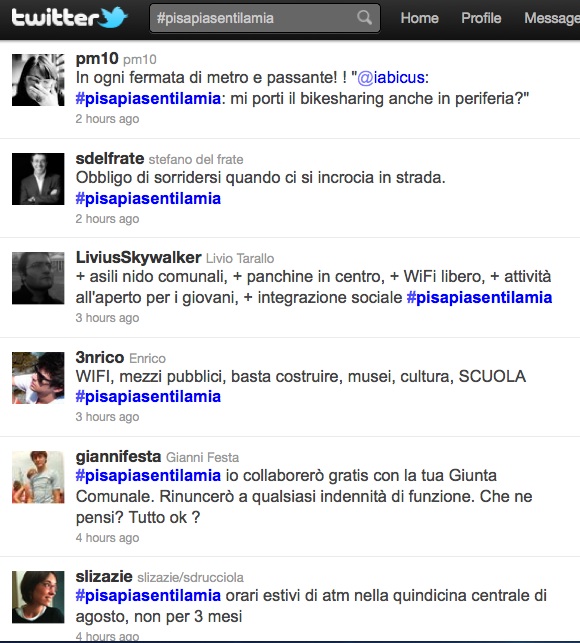
La campagna per le elezioni amministrative di Milano ci ha lasciato un’eredità preziosa: la consapevolezza che tantissimi cittadini vogliono e possono collaborare in modo costruttivo con i propri amministratori pubblici. Grandi numeri, grande energia creativa, strumenti Internet per coordinarsi su obiettivi comuni; il potenziale dei cittadini connessi per contribuire ad un rinnovamento generale del sistema paese è indiscutibile. La società civile italiana ha espresso in questa fase una grande autonomia, almeno pari a quella delle più avanzate esperienze internazionali e probabilmente superiore.
Questa eredità, però, ha anche un lato oscuro. Protagonisti della campagna milanese non sono stati solo i cittadini, ma anche gli esperti di comunicazione su Internet, persone e aziende con un retroterra culturale nel marketing. L’approccio derivato dal marketing si presta bene alle campagne elettorali, perché il voto ha un costo basso o nullo; soglie d’accesso inesistenti; e soprattutto motivazioni spesso emotive o irrazionali. Tutte queste caratteristiche si applicano anche all’acquisto di beni di consumo. E così, gli esperti di comunicazione politica parlano il linguaggio della pubblicità e del marketing: raccontano, per esempio, che Nixon perse le elezioni perché, durante il dibattito televisivo con Kennedy, sudava. Il loro lavoro non è aiutare i cittadini a costruirsi un’idea realistica delle politiche che saranno necessarie per i prossimi cinque anni, ma indurli a votare per un certo candidato, anche se votano per ragioni futili o sbagliate. Non sarà particolarmente nobile, ma, dicono, funziona.
La collaborazione tra cittadini e istituzioni è cosa diversa dalla competizione per il voto, e la similitudine con l’acquisto di beni di consumo non regge. Progettare e attuare politiche pubbliche è un’attività ad alto costo e prolungata nel tempo; richiede argomentazioni razionali, dati, competenze. In questo contesto le tecniche di seduzione del marketing non solo non funzionano bene, ma rischiano di fare danni. In particolare rischiano di produrre bolle nella collaborazione: convincere a partecipare persone che poi, di fronte alla fatica del lavoro di progettazione, si scoraggiano e abbandonano in massa il processo – e così facendo rendono l’intera esperienza negativa per sé e caotica per gli altri. Il problema del governo wiki non è attirare grandi folle di partecipanti, ma abilitare ciascun cittadino a scegliere se e dove impegnarsi, senza tacergli problemi, difficoltà e rischi di fallimento connessi con l’impegno. Anche gli indicatori si leggono in modo diverso che nel marketing: lì attirare più gente è sempre un segno di successo, mentre nel governo wiki può esistere la troppa partecipazione (comporta duplicazione dell’informazione, con molta gente che dice le stesse cose, e riduzione del rapporto segnale/rumore, con gli interventi di bassa qualità che sono molti di più degli interventi di alta qualità).
C’è una differenza profonda nei modelli di decisione sottesi alle due modalità: nel governo wiki i partecipanti si autoselezionano, nel marketing è l’esperto di comunicazione che sceglie il proprio target. Nella collaborazione di tipo wiki il partecipante è visto come un adulto pensante, da informare in modo accurato in modo che possa prendere le proprie decisioni, mentre nella pubblicità il consumatore (o l’elettore) è visto come una persona stupida ed egoista, che risponde a impulsi primordiali e che occorre indurre a fare ciò che noi sappiamo già che va fatto. L’esito della collaborazione ben progettata è aperto e imprevedibile, l’esito della pubblicità ben progettata è il raggiungimento di un obiettivo stabilito a priori.
Insomma, uno scivolamento verso il marketing del discorso sulla collaborazione tra cittadini e istituzioni sarebbe un errore. Un aumento del numero di partecipanti a un singolo processo non vuol dire automaticamente un miglioramento; un sindaco non è un brand; una disponibilità a collaborare non è un trend che va cavalcato nel breve termine (e se lo è diventa inutilizzabile, perché il governo wiki produce risultati in tempi medio-lunghi) e soprattutto, le persone non sono un target, perché non vanno convinte, ma messe in grado di fare ciò che già desiderano. È chiaro che gli italiani sono disposti a collaborare con le loro istituzioni; questa collaborazione ha bisogno di spazio e pazienza per potere crescere sana e forte, al riparo dall’hype e dalle troppe aspettative. Mi auguro che gli uomini e le donne delle istituzioni – a cominciare dal nuovo sindaco di Milano Giuliano Pisapia, simbolo di questa fase – resistano alla tentazione di vedere la collaborazione come una campagna, i cittadini come elettori, la conversazione razionale come persuasione occulta. Cedervi significherebbe farsi del male, e sprecare un’opportunità a cui il nostro paese non può permettersi di rinunciare.


